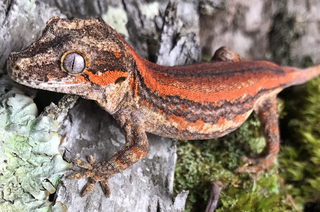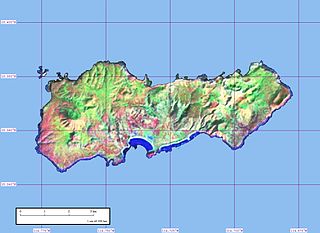
The Phrynosomatidae are a diverse family of lizards, sometimes classified as a subfamily (Phrynosomatinae), found from Panama to the extreme south of Canada. Many members of the group are adapted to life in hot, sandy deserts, although the spiny lizards prefer rocky deserts or even relatively moist forest edges, and the short-horned lizard lives in prairie or sagebrush environments. The group includes both egg-laying and viviparous species, with the latter being more common in species living at high elevations.

Urosaurus is a genus of lizards, commonly known as tree lizards or brush lizards, belonging to the New World family Phrynosomatidae. They are native to North America, specifically the arid and semiarid regions of the western United States and Mexico, spending most of their time on trees, shrubs, or boulders.

The Revillagigedo Islands or Revillagigedo Archipelago are a group of four volcanic islands in the Pacific Ocean, known for their unique ecosystem. They lie approximately 458 kilometres (285 mi) from Socorro Island south and southwest of Cabo San Lucas, the southern tip of the Baja California Peninsula, and 698 to 1,092 kilometres west of Manzanillo. Historically linked to the Mexican state of Colima, to which they were granted in 1861 to establish a penal colony, the islands are under Mexican federal property and jurisdiction.

The gargoyle gecko, knob-headed giant gecko, New Caledonia bumpy gecko, or New Caledonian bumpy gecko is a species of gecko found only on the southern end of the island of New Caledonia. Its habitat is threatened by deforestation on the island. This species of gecko is the smallest of the six recognized species in its genus where they often reach about 125 mm in size. This gecko, along with several other Rhacodactylus species are being considered for protective measures by CITES, which would put restrictions on their exportation. This gecko was first described by Bavay in 1869.

Socorro Island is a volcanic island in the Revillagigedo Islands, a Mexican possession lying 600 kilometres (370 mi) off the country's western coast. The size is 16.5 by 11.5 km, with an area of 132 km2 (51 sq mi). It is the largest of the four islands of the Revillagigedo Archipelago. The last eruption was in 1993.

Clarion Island, formerly Santa Rosa, is the second largest, westernmost and most remote of Mexico's Revillagigedo Islands. The island is located 385 kilometres (239 mi) west of Socorro Island and just under 700 kilometres (430 mi) from the Mexican mainland.

Urosaurus ornatus, commonly known as the ornate tree lizard, is a species of lizard in the family Phrynosomatidae. The species is native to the southwestern United States and northwestern Mexico. The species, which was formerly called simply the "tree lizard", has been used to study physiological changes during the fight-or-flight response as related to stress and aggressive competition. Its life history and costs of reproduction have been documented in field populations in New Mexico and Arizona. This species has been fairly well studied because of its interesting variation in throat color in males that can correlate with different reproductive strategies,

The western long-tailed brush lizard is a species of lizard in the family Phrynosomatidae. The species is native to the southwestern United States and adjacent northern Mexico.

Urosaurus nigricauda is a species of lizard. Common names for this species include the Baja California brush lizard, black-tailed brush lizard, and small-scaled tree lizard. Its range includes southern California, Baja California, and nearby Pacific islands.
Isla Ballena, is an island in the Gulf of California east of the Baja California Peninsula. The island is uninhabited and is part of the La Paz Municipality.
Isla Gallo is an island in the Gulf of California east of the Baja California Peninsula. The island is uninhabited and is part of the La Paz Municipality.

Isla Coronados, is an island in the Gulf of California east of the Baja California Peninsula in Baja California Sur state, Mexico. The island is uninhabited and is part of the Loreto Municipality.
Isla Gallina, is an island in the Gulf of California east of the Baja California Peninsula. The island is uninhabited and is part of the La Paz Municipality.
Isla Islitas, is an island in the Gulf of California east of the Baja California Peninsula. The island is uninhabited and is part of the Loreto Municipality.
Isla Tijeras, is an island in the Gulf of California east of the Baja California Peninsula. The island is uninhabited and is part of the Loreto Municipality.
Urosaurus bicarinatus is a species of lizard. The common name for this species is the tropical tree lizard. Its range is in Mexico.

Urosaurus clarionensis is a species of lizard. The common name for this species is the Clarion Island tree lizard. Its range includes Clarion Island in Baja California.
Urosaurus gadovi, also known commonly as Gadow's tree lizard and el arborícola de Gadow in Mexican Spanish, is a species of lizard in the family Phrynosomatidae. The species is endemic to Mexico.

Urosaurus lahtelai is a species of lizard. The common name for this species is the Baja California brush lizard. Its range is in Mexico.













